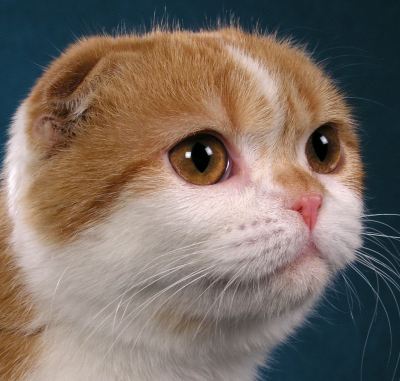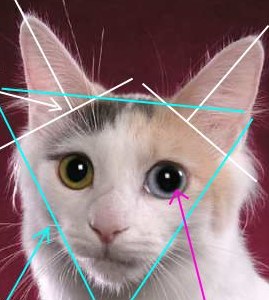
Round Cat Head Shape above. Photo ©copyright
Helmi Flick. Please respect it.

Long head — Photo ©copyright Helmi Flick
Both these photos are cropped versions of the original
Once upon a time there was more or less only one head shape for the small wildcat that became a domestic cat. Obviously, there were some differences, the kind of differences that we see in head shape in humans throughout the world. But the head contains sensory organs and nature dictated that they had to function as well as possible. This meant an optimized and standardized head “design”.
jap bob
That all changed during the time that the cat fancy has been in existence, which is about the past 130 years or so. Domestic cats bred as show cats do not need to rely on their senses to survive. Their purpose is to look good, to conform to the breed standard; to be, in short, of the perfect type, supported by a nice, well balanced, character.

Japanese Bobtail head shape – photo copyright Helmi Flick
In the world of show cats, appearance trumps functionality. I have got to say that there are some fantastic looking cats in the show cat world. Breeders do a wonderful job to produce stunning cats.
Of course, a balance always needs to be struck. Breeders cannot or should not breed extreme appearances no matter how tempting that may be. But it is the desire to create a standout cat appearance that has resulted in a wide range of cat head types. The envelope has been pushed. The boundaries set 100 years ago as to cat head shape have been crossed and now, we have a range of cat head shapes that is probably as wide as it is likely to get…

Sometimes a single breed supports a range of cat head types. The best example is the Siamese, one of the world’s most popular cats with a distinguished history. At one time there was one head type; the “applehead” as it is derogatively called (or so I say). This is the head shape we know. Developments through selective breeding resulted in what is considered by some to be a more refined appearance, the elongated head of what some people call the Modern Siamese. Modern because the cat is a product of the modern world. Recently a sort of U-turn took place in the development of the Siamese cat breed and a cat head shape in between the rounded and the pointed was created; what could be called a classic appearance. There are three head shapes for the Siamese cat with a myriad of subtle variations in between.

Cutting across all the cat breeds, we have, at one end of the spectrum, the roundest cat head shape of all, the Persian’s head (and the head of the Scottish Fold). The breed standard calls for and indeed demands a round head. This means small ears too. To achieve this desirable roundness the muzzle had to be eliminated. The profile is flat and that is demanded in the CFA breed standard. Actually, in terms of strict geometry a face that is flat cannot be part of a round head. Why didn’t the CFA ask for a rounded profile; maybe the cats would have been be able to breath better as a consequence?
Then, skipping over all the purebred cat breeds, at the other end of the spectrum we have the flimsy foreign cats, the Oriental body shapes and long faces. The paradigm long faced cat is the Modern Siamese. A close associate is the Oriental Shorthair. The Cornish Rex is at the far end of the spectrum too….
So, what is the spectrum of cat head shapes? How best to describe it and set it out? Let’s use something new, the roundness factor (RF). Where RF=10 the cat head shape is perfectly round. Where RF=0, the head is extremely long, the opposite to round. Here, according to me, is how the cat breeds stack up using the RF standard:
RF=10 means the most rounded
RF=1 means the least rounded
| Cat Breed | RF | Comment |
| Ultra Persian | 9 | No cat head can be completely round and in any case the Persian’s face is meant to be flat.The Traditional Persian cat has a more normal but still round head; perhaps at 7-8 on this scale. |
| Ultra Himalayan | 9 | Same as Persian but pointed. |
| Exotic Shorthair | 9 | A shorthaired Ultra Persian. |
| Scottish Fold | 8 | See header photo — The ears uniquely support a round headed appearance although the head is less round than the Ultra Persian. Without the flat ears this cat would be a 7 or 6. |
| Selkirk Rex | 8 | A little like a Persian but less extreme than the Ultra version of the Persian. |
| British Shorthair | 8 | Bred to have a nice, round and open face. |
| American Burmese | 7 | The UK Burmese is less rounded. |
| Birman | 7 | Fur ball. |
| Cymric | 7 | This is a cobby cat. |
| Ragdoll | 7 | This cat has a substantial body type to match.Photo (cropped) copyright Helmi Flick. |
| Manx | 7 | Shorhaired Cymric. |
| American Shorthair | 7 | Bred to be solid looking. |
| American Wirehair | 7 | Like the American Shorthair in terms of head shape. |
| Traditional Siamese | 6 | The original Siamese head shape, I say. This is a controversial area. |
| Moggie | 5 | This is the Household Pet as the CFA calls her/him. This is the mid-range by default.This photo is a cropped photo ©Helmi Flick. |
| Abyssinian | 4 | An athletic cat with a foreign body shape. |
| Bengal | 4 | Athleticism is the benchmark for this cat’s appearance and a wild face.Photo (cropped) copyright Helmi Flick. |
| Egyptian Mau | 4 | Refined when a show cat. The slightly longer cat head shape could be regarded as more refined |
| Havana Brown | 4 | Elegant frame all around.Photo (cropped) copyright Helmi Flick. |
| Japanese Bobtail | 4 | Equilateral triangle. |
| Thai | 4 | Another version of the Siamese cat. This could be called the Classic Siamese. |
| Korat | 3 | One of the grey cat breeds. |
| Sphynx | 3 | Solid body, bony slightly slender head. |
| Cornish Rex | 2 | Very rangy, slender body and head. |
| Modern Balinese | 1 | Long haired Modern Siamese. |
| Modern Siamese | 1 | The Quintessential long faced cat with the Oriental SH, a close cousin. |
| Oriental Shorthair | 1 | Same as Modern Siamese.The photo is ©copyright Helmi Flick (a cropped version of the original). |
The cat head shape follows the cat body type — I guess that is almost obvious. See Cat Body Types.
Cats not listed here will fall in the mid-range of cat head shape.
Note: this is my assessment. I used the Legacy of the Cat by Gloria Stephens as a guide. Nothing is set in concrete and there will be people who disagree. These are simply my thoughts. This is not an encyclopedia. And even in an encyclopedia differences of opinion occur.


Pleasure Barbara.
Thanks for the info~
It was fun going through this list. I’d like to spend a little time with one of each of these breeds of cat.
Hi Amanda, I agree. Not enough effort is made to ensure that modern Siamese cats have good health. Extreme breeding is selfish human behavior. Please send me the pictures of your Tonkinese by email on:
mjbmeister[at]gmail.com
Change [at] for @
It’s awful the way they breed Siamese to have such a narrow head with their eyes on the sides like a fish! Cats are predators and meant to have the eyes on the front of their face. This is really messing up their brains and there is scientific evidence of neurological problems.
I chose a Tonkinese because I had a rescue one and to me this is the most balanced of the current fancy breeds, it was in fact developed to counter the head problems both of the contemporary Siamese and Burmese (look up Burmese head fault). I think there are also breathing issues because the nasal passages can get so easily blocked especially if they are unlucky enough to pick up cat flu.
If you like I can send you pictures of the Tonkinese. American ones vary from European in the same way as the Burmese do because the Burmese breed is one of the foundation breeds. My Tonk Mojo has quite a long face and is very much like the Siamese I grew up with in the 1970s/80s.